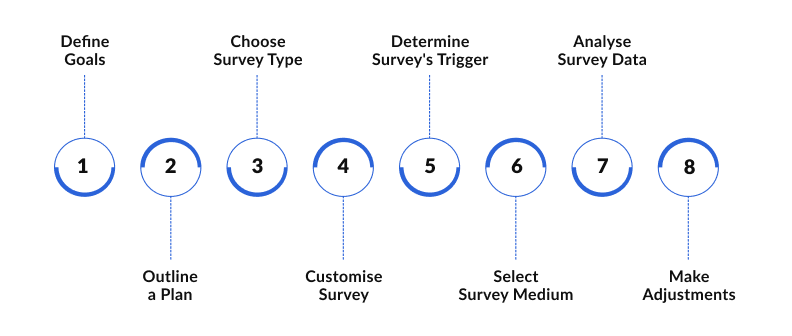Loading.....
How to Measure Customer Satisfaction Like a Pro

In today's fiercely competitive business landscape, customer satisfaction stands as a pivotal metric that can make or break your success. It is a crucial metric for any business, as it directly impacts customer loyalty, retention, and ultimately, the bottom line. Satisfied customers not only become loyal advocates but also fuel business growth through positive word-of-mouth and repeat purchases. Let’s learn more about the intricacies of understanding how to measure customer satisfaction and why it's essential to employ various metrics that provide insights into different aspects of the customer experience.
What Is Customer Satisfaction And Its Benefits?
Customer satisfaction is a measure of how well a company's products or services meet or exceed customer expectations. It reflects the customer's overall experience and their perception of the value received from a business. Achieving high levels of customer satisfaction involves consistently delivering quality products or services, addressing customer needs and concerns, and creating a positive buying experience.
Benefits
- Repeat Business and Loyalty
- Positive Reviews and Word-of-Mouth
- Reduced Churn Rate
- Higher Profits
- Innovation and Improvement
Types Of Metrics That Measure Customer Satisfaction
To ensure your customers are content and loyal, it's essential to measure and analyze their satisfaction levels. But the question remains: how do you measure customer satisfaction, and what types of metrics should you use to measure customer satisfaction?
There are various metrics that can be employed to gauge customer satisfaction, providing valuable insights to enhance your products, services, and overall customer experience. Here are the top 3 metrics for measuring customer satisfaction.
1. Customer Satisfaction Score (CSAT)
Customer Satisfaction Score, commonly known as CSAT, is a metric used by businesses to measure how satisfied their customers are with their products or services. It is typically measured using a survey that asks customers to rate their satisfaction on a scale, often from 1 to 5 or 1 to 7, with 1 being highly dissatisfied and the highest number indicating complete satisfaction.
The CSAT survey typically includes a question like, "How satisfied are you with our product/service?" Customers choose a rating representing their level of satisfaction.

2. Net Promoter Score (NPS)
Net Promoter Score, commonly referred to as NPS, is a customer loyalty metric developed by Fred Reichheld, Bain & Company, and Satmetrix in 2003. It measures the likelihood of customers to recommend your products or services to others.
NPS is based on a single question that is typically presented to customers through customer satisfaction surveys: "On a scale of 0 to 10, how likely are you to recommend our company/product/service to a friend or colleague?" Based on the responses, they are categorized into three groups:
- Promoters (Score 9-10): These are highly satisfied and loyal customers who are likely to recommend your business to others.
- Passives (Score 7-8): Passives are satisfied but not enthusiastic customers. They are less likely to actively promote your business but are also less likely to speak negatively about it.
- Detractors (Score 0-6): Detractors are dissatisfied customers who may not only refrain from recommending your business but may also actively discourage others from engaging with it.

3. Customer Effort Score (CES)
Customer Effort Score, often abbreviated as CES, is a customer satisfaction metric that evaluates the ease of a customer's interaction with a company or brand. It measures the level of effort a customer has to put forth to accomplish a specific task, such as resolving an issue, making a purchase, or seeking information.
CES is typically measured using a survey question that asks customers to rate their experience based on a scale, usually ranging from "Very Easy" to "Very Difficult."
The specific question could be framed as follows: "On a scale of 1 to 7, how easy was it for you to [a particular task, e.g., resolve your issue, make a purchase]?"

Customers then select a rating that best represents their experience. The scores are usually aggregated, and the average CES score is calculated. A higher CES score indicates that customers find it easier to interact with your business, while a lower score suggests that customers encounter more difficulties.
Roadmap To Measure Customer Satisfaction
Now that we've uncovered the significance of customer satisfaction and the metrics, let's explore how to measure customer satisfaction efficiently.

Define Your Goals: Before embarking on your measurement journey, establish clear objectives. Determine what specific aspects of customer satisfaction you want to assess and improve.
Plan Outline: A well-thought-out plan is essential for successful measurement. Define the scope, timeline, and resources required for your customer satisfaction assessment.
Choose Type of Customer Satisfaction Survey: Select the most appropriate survey type based on your goals. Options include post-purchase surveys, email questionnaires, phone interviews, and in-app feedback forms.
Customize Layout and Questions: Craft customer satisfaction surveys that align with your brand's tone and objectives. Tailor questions to gather relevant insights about the customer experience.
Determine Triggers: Decide when and where to trigger your surveys. Consider timing them after key customer touchpoints, such as purchases or support interactions.
Select Medium: Choose the right channel for survey distribution. It could be email, SMS, your website, or even in-person interviews, depending on your target audience.
Analyze Data: Once you've collected data, perform in-depth analysis to derive actionable insights. Identify trends, patterns, and areas that need immediate attention
Make Adjustments and Repeat: Use the insights from your analysis to implement improvements. Continuously monitor customer satisfaction and iterate on your strategies for ongoing enhancements.
Tools And Techniques For Gathering Data
To measure customer satisfaction effectively, businesses rely on a variety of tools and techniques. Here are the most popular and effective methods for gathering customer satisfaction data:
- Customer Satisfaction Surveys and Questionnaires: One of the most common methods to collect customer satisfaction data is through surveys and questionnaires. Tools like SurveyMonkey, Google Forms, and Typeform make it easy to create, distribute, and collect responses from customers. When designing your surveys, ensure they are concise, specific, and user-friendly to encourage higher response rates.
- Social Media Listening: Social media platforms are treasure troves of customer feedback. Utilize tools like Hootsuite or Brandwatch to monitor mentions, comments, and reviews related to your brand. Analyzing sentiment and identifying trends can provide valuable insights into customer satisfaction levels.
- Customer Support Interactions: Customer support interactions, including live chat, email, and phone calls, contain valuable data. CRM (Customer Relationship Management) systems like Salesforce or Zendesk can help track customer interactions and identify common issues or concerns.
- Online Reviews and Feedback: Platforms like Yelp, TripAdvisor, and Google Reviews are hubs for customer feedback. Demonstrate your commitment to customer satisfaction by regularly monitoring and responding to reviews, both positive and negative, to d
Analyzing And Acting On Customer Satisfaction Data
Measuring customer satisfaction data is a goldmine of insights that can help you enhance your products, services, and overall customer experience. Analyzing this data can help you identify areas for improvement, enhance customer loyalty, and ultimately boost your bottom line. Let’s explore, we will explore how to effectively act on customer satisfaction data to improve your business's performance.
- Prioritize Issues: Identify the most critical issues affecting customer satisfaction. Focus on areas with the greatest impact on your business, such as product quality, customer service, or delivery speed.
- Set Clear Goals: Define specific, measurable, and realistic goals for improvement. For instance, if customers frequently complain about slow response times, set a goal to reduce response times by a certain percentage within a defined timeframe.
- Implement Changes: Collaborate with relevant departments to implement necessary changes. This could involve improving training for customer service representatives, enhancing product features, or streamlining order processing.
- Monitor Progress: Use customer satisfaction metrics and feedback to continuously monitor the impact of your actions and track improvements over time. Adjust your strategies accordingly to achieve your targeted goals.
- Communication: Keep your customers informed about the changes you're making based on their feedback. Transparency can help rebuild trust and loyalty.
Real-Life Examples: Kroger Customer Satisfaction Surveys
Kroger, one of the largest supermarket chains in the United States, has consistently ranked high in customer satisfaction. Kroger customer satisfaction surveys are a critical component of their strategy.

- In-Store Surveys: Kroger uses various in-store methods to collect customer feedback. These include printed survey invitations on receipts, kiosks within the store, and even direct interactions with staff who encourage customers to participate. This multi-pronged approach ensures a wide range of customers are reached.
- Online Accessibility: In addition to in-store surveys, Kroger customer satisfaction survey provides an online platform for customers to give feedback. This flexibility caters to customers who prefer the convenience of providing feedback from the comfort of their homes.
- Survey Clarity: Kroger's customer satisfaction surveys are designed to be clear and concise. They focus on specific aspects of the shopping experience, such as the availability of products, cleanliness of the store, and staff friendliness. This targeted approach helps Kroger gather actionable insights.
- Reward Programs: Kroger often rewards customers for participating in their surveys. They offer discounts on future purchases or entry into sweepstakes. This not only incentivizes customers but also encourages them to return to the store.
- Closed-Loop Feedback: Kroger follows a closed-loop feedback system. When a customer raises an issue or concern in the survey, the company ensures that it is resolved promptly. This not only addresses individual grievances but also showcases their commitment to improving the overall customer experience.
Conclusion
In conclusion, measuring customer satisfaction is not just a business metric; it's a cornerstone of success in today's competitive market. Understanding how your customers perceive your products and services is essential for fostering loyalty, garnering positive reviews, and driving profitability.
 Back to blog
Back to blog












